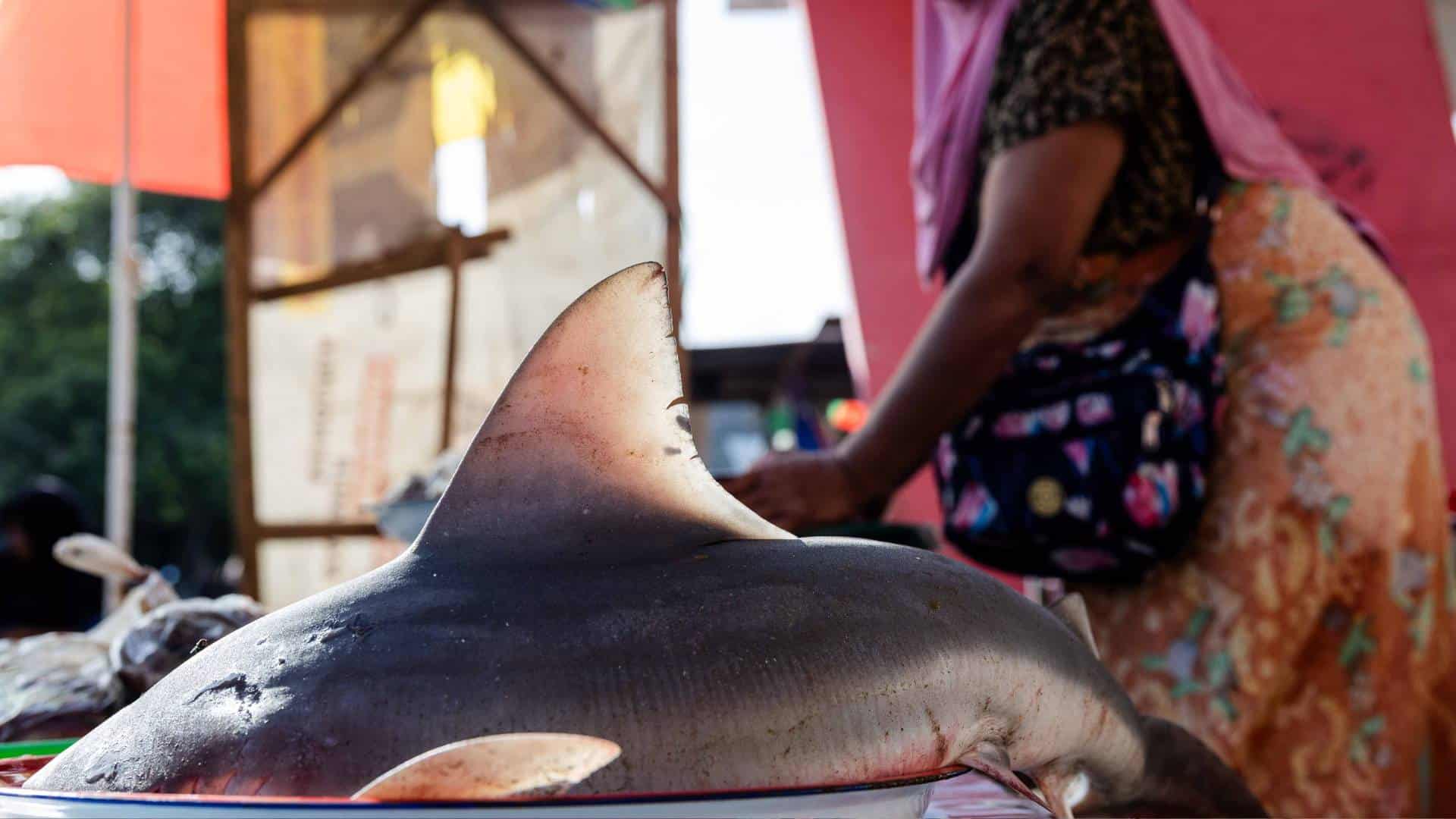All parts of a shark can be eaten. Some parts are worth a whole lot of money and that makes them hunted and endangered. Can sharks and shark eaters coexist?

A freshly-caught shark is displayed for sale a traditional market in Tanjung Luar, on the Indonesian island of Lombok, 21 February 2025. (Photo by Garry Lotulung)
This article was produced exclusively for News Decoder’s global news service. It is through articles like this that News Decoder strives to provide context to complex global events and issues and teach global awareness through the lens of journalism. Learn how you can incorporate our resources and services into your classroom or educational program.
In the fishing village of Tanjung Luar you will find one of the largest shark markets in Southeast Asia. The village, on the island of Lombok, faces the Indian Ocean. The majority of the population there live in coastal areas and rely on sharks for their livelihoods and food security.
With Spain and India, Indonesia is one of the world’s largest shark fishing nations and a major exporter of shark products, including fins, liver oil, meat and skin. Of the world’s 1,250 shark species, 218 patrol reefs and deep-sea troughs across Indonesia.
Sharks also play an important role in the ecosystem. According to the nonprofit group Oceana, the threat of sharks forces smaller prey to relocate which changes up their feeding on other fish. This helps maintain coral reefs and seagrass.
When the village fishermen bring in their catch, they move the sharks from their boats to the shore. They take turns placing their catch among other sharks to be sold at auction. They cut each shark’s fins from its body and sell the fins and meat separately.
In Tanjung Luar, most fishermen sell shark meat directly to the community at the landing site or take the meat to local markets. But if they catch more than three sharks, they can sell the catch to shark meat traders.
Not all sharks can be hunted.
It is prohibited to hunt whale sharks, as well as manta rays and sawfish, two closely-related species.
“We fishermen here know what is prohibited,” said Suparman, one of the shark collectors in Tanjung Luar. Suparman said that he would not buy whale shark, or take it even if it were offered to him for free. Fishermen, like Suparman, know they can be arrested if they violate the sanctions.
“Fishermen do not dare to catch them at all,” Suparman said.
Long before the ban on whale sharks, which are the largest existing fish species known, Tanjung Luar fishermen believed that whale sharks brought good luck and should not be hunted.
The appearance of whale sharks indicates that the waters are full of small fish. Fishermen will fish around the path passed by the whale sharks.
“Fishermen believe that whale sharks should not be caught,” he said.
Fishing for shark
On the other hand, for other types of sharks, as long as they are not prohibited and there are still many orders for their fins and meat, fishermen will continue to catch sharks.
Fishermen in Tanjung Luar need 15-20 days to hunt sharks, and will catch dozens in that period, said Safruddin, a fisherman who specialises in sharks. When he is not out at sea, he also works as a shark seller at market, cutting the fins into the desired pieces and selling them to shark warehouses.
The fishermen catch shark on wooden boats with gas-powered engines. The operational costs of going to sea are relatively high, reaching 15 million Indonesian rupiahs per trip or more than U.S. $900 at the current exchange rate. They use drift longline and bottom longline fishing rods.
Safruddin said that it is difficult to stop fishermen from catching sharks in East Lombok.
“This has been a hereditary job from the previous generation to our generation,” he said. “And this has become a daily livelihood for the people here to make a living and the market price is still promising.”
The fins, meat, skin, bones and teeth all bring in money.
A dwindling supply
Together, the fishermen in Tanjung Luar can bring in around 10-30 sharks a day weighing 20-30 kilograms each. The sharks are sold at at auction for 600,000–1 million rupiahs per shark, or $35–$62 each.
The market can accept 200 sharks a day and a decade ago, fishermen could meet that demand. But not these days, as overfishing has diminished the ocean’s supply.
The World Wildlife Fund estimates that more than 270,000 sharks are killed every day. Often targeted for their fins, this practice affects many different shark species, including whale sharks.
One way people kill sharks is through shark finning. This involves catching sharks, removing their fins and discarding them back into the ocean, where they often die slow deaths. Indonesia is the biggest contributor to shark deaths in the world, along with other tropical countries including Brazil, Mauritania and Mexico. Overfishing is now driving most species to extinction.
Shark fins are in demand due to their monetary and cultural value. While all parts of the shark’s body are sold, harvesting the fins, the most expensive part, has long been controversial; the price of a fin alone can reach the equivalent of 3 million rupiahs or about $185 per kilogram for exports to China, Thailand, Hong Kong and Japan.
A feeding frenzy
People in China consider shark fins a delicious food, and believe they are an aphrodisiac and a cure for cancer. With the rise of the middle class in China, the demand for shark fins has skyrocketed there.
Japan is also a major market, with more than half of Indonesia’s shark fin exports flowing to that country. In the past five years, Japan has imported more than $2 million a year worth of shark fins from Indonesia, reflecting high demand despite the global push for shark protection.
The trade of shark fins in East Lombok Island is regulated by the Indonesian government. Its implementation is the responsibility of the Coastal and Marine Resources Management Centre which has the authority to provide permits and legalisation for traders.
In Tanjung Luar, only two traders have permits. The legal traders work with the shark fishers to keep within the quota set by the government and are monitored by several government agencies.
In the past, the shark’s body would be thrown away after the fins were cut off. But the local community now processes shark meat into foods such as meatballs, satay and smoked meat, which can be sold at a much more affordable price.
An illegal trade continues.
A common shark culinary product is shark satay. One skewer of shark satay is priced at 5,000 rupiahs, or about 30 cents, and the skewers are distributed to several traditional markets in East Lombok that sell shark meat.
Besides the legal trade of permitted catches, there is an illegal trade of hammerhead and lanceolate sharks, both of which are listed as endangered by the International Union for Conservation of Nature and Natural Resources or IUCN. The Indonesian government regulates the capture, maintenance and trade of endangered species.
The latest IUCN reports that in the last 20 years, the global demand for shark meat has nearly doubled, with the value of shark and ray meat now 1.7 times the value of the global fin trade. Over that time, the trade has diversified significantly and today, products such as ray gill plates, liver oil and skins are valued at nearly $1 billion each year.
At the same time, conservationists are starting to see efforts from governments like Indonesia to preserve the populations of sharks and other endangered marine life. Armed with two decades of research and major policy changes, groups like the IUCN are devising country-specific solutions to guide governments in implementing conservation measures and sustainable fisheries.
“Almost 20 years after the first report, there have been drastic changes,” said Alexandra Morata, programme officer of the Shark Specialist Group of the IUCN Species Survival Commission, “with sharks and rays now among the most threatened vertebrates on the planet.”
Questions to consider:
1. Why is there so much money to be made in shark fishing?
2. In what ways is the Indonesian government trying to conserve sharks?
3. How would you go about protecting endangered fish if you were a government official?

Garry Lotulung is a freelance photojournalist and documentary photographer based in Jakarta. Lotulung has specialized in stories about the human condition, social change and environmental crises. Lotulung joined the international news agency Anadolu Agency in 2022 and has been a regular contributor and stringer since.
